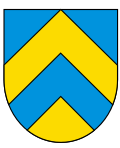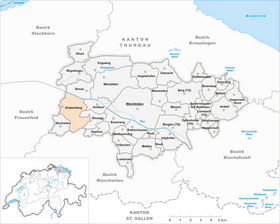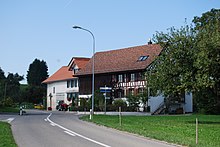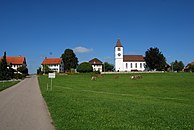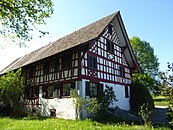Griesenberg
| Griesenberg | ||
|---|---|---|
| State : |
|
|
| Canton : |
|
|
| District : | Weinfelden | |
| Political community : | Amlikon-Bissegg | |
| Postal code : | 8514 (Amlikon-Bissegg) | |
| former BFS no. : | 4883 | |
| Coordinates : | 718 447 / 269 998 | |
| Height : | 544 m above sea level M. | |
| Area : | 6.63 km² | |
| Residents: | 352 (1990) | |
| Population density : | 53 inhabitants per km² | |
| map | ||
|
|
||
Griesenberg is a hamlet in the municipality of Amlikon-Bissegg in the Weinfelden district of the canton of Thurgau in Switzerland and a former municipality in the then Amlikon municipality . On January 1, 1995 , Griesenberg merged with the municipalities of Amlikon, Bissegg and Strohwilen to form the political municipality of Amlikon-Bissegg.
geography
The sprawling local community of Griesenberg on the Wellenberg includes the hamlets of Altenburg, Bänikon, Fimmelsberg (mentioned in a document as Vilmarsperc in 1228 ), Holzhof, Leutmerken and Tümpfel as well as other settlements.
history
The 1256 first mentioned Griessinberc was an old St. Gallen monastery possession, of the High Middle Ages, the Barons of Bussnang shelter. At the beginning of the 13th century, the western half of the Bussnang sphere of influence became an independent rule. Its administrative center was Alt-Griesenberg Castle , after its destruction in 1289 by the Habsburgs Neu-Griesenberg .
![]()
![]()
After the death of the last member of the family, Lütold von Griesenberg, the rule came to his daughter Adelheid in 1325. In 1367 it had to be pledged to the Harzer brothers from Constance before it was sold to the Constance citizen Konrad von Hoff in 1397 by Adelheid's daughter from his first marriage, Clementia. In the 15th and early 16th centuries it came into the possession of various families until it was acquired by Heinrich von Ulm , a citizen of Constance, in 1529 . They sold his descendants to the city of Lucerne in 1759 . This in turn found a buyer in Wolf Dreyfus in 1793. The property came to the Schulthess family from Zurich in 1795 via Karl Anton Kraft, the Austrian chief magistrate in Stockach . A court opening in 1475, which was renewed in 1605, determined the rights of the rulers. In 1791 the community of Griesenberg was founded and in 1749 the community of Benikon, which merged with Griesenberg in 1813. With the conversion of court lord Marx von Ulm in 1607, the Counter Reformation began.
Griesenberg was subordinate to Leutmerken, which was reformed in 1529. In 1548 the Constance reformer Ambrosius Blarer fled to Leutmerken, where he worked as a Protestant pastor in 1548 and 1563. The Leutmerken church was first mentioned in 814. With the conversion of court lord Marx von Ulm in 1607, the Counter Reformation began.
Grain cultivation prevailed until the 19th century, then cattle and dairy farming and field fruit growing. The Holzhof, owned by the Wartmann family from 1858, is one of the cradles of the Swiss Tilsiter , which has been produced since around 1893. In 1934 the road in Bänikon was covered with a waste oil layer.
population
| year | 1850 | 1900 | 1950 | 1990 | 2000 | 2010 | 2018 |
|---|---|---|---|---|---|---|---|
| Local parish | 500 | 438 | 397 | 352 | |||
| Hamlet of Griesenberg | 20th | 19th | 15th | ||||
| Banikon | 118 | 121 | 105 | ||||
| Fimmelsberg | 43 | 49 | 42 | ||||
| source | |||||||
Personalities
- Otto Wartmann (1890-1959): Thurgau Grossrats president and National ( BGB , 1935-1959); Cheese maker in Holzhof, brought Tilsit cheese to Switzerland
- Bruno Haag, resident in Leutmerken: President of the Thurgau Grand Council (1992)
Attractions
The Leutmerken parity church was first mentioned in 1275. Griesenberg and the hamlet of Leutmerken are listed in the inventory of places worthy of protection in Switzerland . The following buildings are protected cultural assets :
Eschikofer Bridge over the Thur
See also
Individual evidence
- ↑ Swiss land use statistics. Completed on July 1, 1912. Published by the Federal Statistical Bureau. ( Memento from April 12, 2016 in the Internet Archive )
-
↑ a b c d e f g h i André Salathé: Griesenberg. In: Historical Lexicon of Switzerland .
These sections are largely based on the entry in the Historical Lexicon of Switzerland (HLS), which, according to the HLS's usage information, is under the Creative Commons license - Attribution - Share under the same conditions 4.0 International (CC BY-SA 4.0). - ↑ a b Localities and their resident population. Edition 2019 . On the website of the Statistical Office of the Canton of Thurgau (Excel table; 0.1 MB), accessed on April 28, 2020.
- ↑ a b List of archaeological sites. On the website of the Office for Spatial Development of the Canton of Thurgau, June 2009 (PDF; 0.1 MB)
- ↑ a b c Full story. On the website of the municipality of Amlikon-Bissegg, accessed on November 29, 2019
- ↑ Verena Baumer-Müller: Blarer, Ambrosius. In: Historical Lexicon of Switzerland .
- ↑ Locations and Settlements Directory. Canton of Thurgau, 2005 edition . On the website of the Statistical Office of the Canton of Thurgau (PDF; 1.7 MB), accessed on April 28, 2020.
- ↑ List of settlements. Canton of Thurgau, edition 2019 . On the website of the Statistical Office of the Canton of Thurgau (Excel table; 0.2 MB), accessed on May 10, 2020.
- ↑ a b c Anniversary chronicle - 1200 years of Leutmerken . Published by the "1200 Years of Leutmerken" organization committee, c / o Amlikon-Bissegg municipal administration. Retrieved November 29, 2019.
